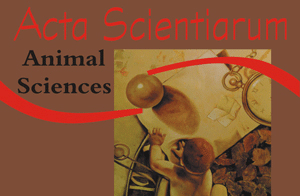Resumo em Inglês:
ABSTRACT. The objective of this study was to determine the multivariate relationship among linoleic acid, alpha-linolenic acid, and their main rumen biohydrogenation (BH) intermediates and products in bovine rumen fluid using canonical correlation analysis (CCA). A dataset consisting of 1177 observations generated by 107 in vitro rumen incubation systems of pure and mixed linoleic acid (18:2-c9, c12) and alpha-linolenic acid (18:3-c9, c12, c15) was gathered. Two canonical variates were defined: A: composed of the nine main BH intermediates and products (18:2-c9, t11; 18:2-t11, c15; 18:1-t11; 18:1-t9; 18:1-t6; 18:1-c11; 18:1-c6; 18:1-c9; 18:0) of 18:2-c9, c12 and 18:3-c9, c12, c15 and B: composed of 18:2-c9, c12 and 18:3-c9, c12, c15. Two canonical functions between A and B with significant canonical correlations (R1=0.990 and R2=0.738; p <0.01) were obtained. However, only the first function was selected for CCA. Exploration of canonical loadings for first function, revealed the following quantitative significance (absolute value) order for fatty acids (FA) within their respective canonical variates: A: 18:0(0.958)>18:1-t9(0.837)>18:1-c11(0.835)>18:1-c6(0.824)>18:1-t11(0.747)>18:1-c9(0.738)>18:1-t6(0.415)>18:2-t11, c15(0.387)> 18:2-c9, t11(0.239); B: 18:2-c9, c12(0.667)>18:3-c9, c12, c15(0.488). The CCA showed that 18:2-c9, c12 has a greater contribution than that of 18:3-c9, c12, c15 on the production of the aforementioned BH intermediates, in which 18:0, as well as the groups of 18:1 cis and trans-FA were mainly affected.
